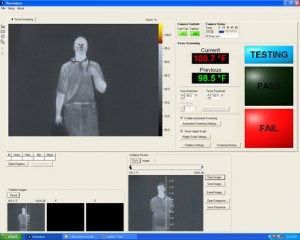If you listen, you can hear them talking. Sometimes the conversation is loud and clear. In On the Heavens, Aristotle argues that the Earth has no motions. It neither orbits the Sun nor turns on an axis. Just under two thousand years later, Galileo upbraids him. In Dialogue Concerning the Two Chief World Systems, he presents a fictional debate, entrusting the Copernican argument to the capable Salviati and consigning the Aristotelian to the credulous Simplicio. When their discussion reaches the subject of the motions of the Earth, Simplicio triumphantly produces a copy of On the Heavens (“I keep it always in my pocket,” which, in Galileo-speak, suggests: He would). Salviati then proceeds to demolish Aristotle’s reasoning by using his own words against him.

You feel lousy. Some old lady sneezed on you in the subway. Now you’re achy and tired and feverish. Face it, Bud. You’ve got the flu. Better just crawl back into bed.
What’s that? You have to fly to London? You’ve got an important meeting with a client? Well, I guess I can’t stop you. But someone else can. It’s the airport fever police. They spotted your hot head with their thermal scanner as you made your way into the airport. Continue reading
 Nature certainly works in dark, mysterious ways. A few weeks ago, we marveled here at the seemingly miraculous return of 35 million sockeye salmon to Canada’s Fraser River, after many people feared that the run was nearing extinction.
Nature certainly works in dark, mysterious ways. A few weeks ago, we marveled here at the seemingly miraculous return of 35 million sockeye salmon to Canada’s Fraser River, after many people feared that the run was nearing extinction.
As Canadians were rejoicing, however, fisheries scientists were frantically working their chalkboards, trying to figure out what on earth was going on. Now someone has come up with a theory. The greatest Fraser River run in nearly a century may have been due to two events: the eruption of Kasatochi volcano in the Aleutian Islands in August 2008, and the winds of a perfect storm. Continue reading

Scattered around the periphery of our galaxy, the Milky Way, are upwards of 150 odd creatures called globular clusters. They’re little agglomerations of stars that are bound by gravity into a sphere and that inside it, are buzzing around like flies. They’re odd because 1) most stars come in singles or pairs, and globulars have hundreds, maybe thousands, maybe millions of stars – and that quantification alone tells you how much astronomers know about them; and 2) most stars are relatively young; and globulars are so old they set a lower limit on the age of the universe, which after all, can’t be younger than its own stars. What are they doing out there? A famous astronomer told me, “We know zip, I think.” Continue reading
 It’s the end of October—a dark time, and not only because of Halloween ghouls. Today in New York City, we won’t see the sun until 7:19am, and we’ll have to say good-bye at 6:00pm. Each passing day will be distressingly shorter than the day before, until December 21, when the sun will set at 4:31pm, the pattern will reverse, and each passing day will give us a bit more time under the sun.
It’s the end of October—a dark time, and not only because of Halloween ghouls. Today in New York City, we won’t see the sun until 7:19am, and we’ll have to say good-bye at 6:00pm. Each passing day will be distressingly shorter than the day before, until December 21, when the sun will set at 4:31pm, the pattern will reverse, and each passing day will give us a bit more time under the sun.
For the millions of people with seasonal affective disorder, a.k.a. SAD, spring couldn’t come soon enough. The depletion of light triggers bouts of depression—characterized by lethargy, lack of interest in regular activities, hopelessness and even suicidal thoughts—as well as oversleeping, carb-craving and weight gain.
Continue reading

Q: What happened before the Big Bang?
Mr. Cosmology: If I told you, God would have to kill you.
Q: What is time?
Mr. Cosmology: Is 9:30.
Q: I just bought a telescope. Do you have any advice for a first-time sky watcher?
Mr. Cosmology: What happens in Vega, stays in Vega.
Q: How many stars are there in the universe?
Mr. Cosmology: Count all the grains of sand on Earth. When you’re done, I’ll tell you.
 The Italian press recently had a field day in its coverage of the sad decline of one of Italy’s greatest tourist draws: Pompeii. In early October, a prominent Italian newspaper ran a front-page editorial on the subject, calling the crumbling Roman ruins a “symbol of all the sloppiness and inefficiencies of a country that has lost its good sense.” Soon after, Italian politicians leaped into the fray, taking aim at the deep cuts that Silvio Berlusconi’s government has made in cultural funding since 2007.
The Italian press recently had a field day in its coverage of the sad decline of one of Italy’s greatest tourist draws: Pompeii. In early October, a prominent Italian newspaper ran a front-page editorial on the subject, calling the crumbling Roman ruins a “symbol of all the sloppiness and inefficiencies of a country that has lost its good sense.” Soon after, Italian politicians leaped into the fray, taking aim at the deep cuts that Silvio Berlusconi’s government has made in cultural funding since 2007.
Such cutbacks are certainly not helping Pompeii. Its grand villas and delicate frescoes require almost constant maintenance and restoration–a very expensive proposition. And there are a lot of them to maintain. But I keep thinking about a conversation I had with a prominent archaeologist over lunch at Pompeii a few years ago, when he brought up the problem of awarding contracts for such work in a region long controlled by the Camorra, a powerful, secretive criminal organization based in nearby Naples.
 The coordinate grid was laid against the sky to fix the stars and for centuries it seemed to work as planned.
The coordinate grid was laid against the sky to fix the stars and for centuries it seemed to work as planned.
Recently, slowly, almost asymptotically, the grid begins to move with respect to itself — abrading, degrading — and therefore deteriorates.
In fact, Declination -14 now sags along its whole length so that Declination +14 is taut and hums like a violin string in a high wind. Right Ascension 23 has rusted through and swings from its jointure, knocking the vernal equinox out of line.
This year spring came not late exactly, but more toward the center. Continue reading
